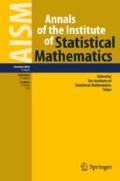Abstract
In situations where limited knowledge of a system exists and the ratio of data points to variables is small, variable selection methods can often be misleading. Freedman (Am Stat 37:152–155, 1983) demonstrated how common it is to select completely unrelated variables as highly “significant” when the number of data points is similar in magnitude to the number of variables. A new type of model averaging estimator based on model selection with Akaike’s AIC is used with linear regression to investigate the problems of likely inclusion of spurious effects and model selection bias, the bias introduced while using the data to select a single seemingly “best” model from a (often large) set of models employing many predictor variables. The new model averaging estimator helps reduce these problems and provides confidence interval coverage at the nominal level while traditional stepwise selection has poor inferential properties.
Similar content being viewed by others
References
Akaike H. (1973) Information theory as an extension of the maximum likelihood principle. In: Petrov B.N., Csaki F. (eds) Second international symposium on information theory. Budapest, Akademiai Kiado, pp 267–281
Akaike H. (1978) On the likelihood of a time series model. The Statistician 27: 217–235
Akaike H. (1979) A Bayesian extension of the minimum AIC procedure of autoregressive model fitting. Biometrika 66: 237–242
Anderson D.R. (2008) Model based inference in the life sciences: primer on evidence. Springer, New York
Buckland S.T., Burnham K.P., Augustin N.H. (1997) Model selection: An integral part of inference. Biometrics 53: 603–618
Burnham K.P., Anderson D.R. (2002) Model selection and multimodel inference: A practical information-theoretic approach (2nd ed.). Springer, New York
Burnham K.P., Anderson D.R. (2004) Multimodel inference: understanding AIC and BIC in model selection. Sociological Methods and Research 33: 261–304
Claeskens G., Hjort N.L. (2008) Model selection and model averaging. Cambridge University Press, New York
Freedman D.A. (1983) A note on screening regression equations. The American Statistician 37: 152–155
George E.I., McCulloch R.E. (1993) Variable selection via Gibbs sampling. Journal of the American Statistical Association 88: 881–889
Hoeting J.A., Madigan D., Raftery A.E., Volinsky C.T. (1999) Bayesian model averaging: a tutorial (with discussion). Statistical Science 14: 382–417
Hurvich C.M., Tsai C.-L. (1989) Regression and time series model selection in small samples. Biometrika 76: 297–307
Hurvich C.M., Tsai C.-L. (1990) The impact of model selection on inference in linear regression. The American Statistician 44: 214–217
Massart P. (2007) Concentration inequalities and model selection. Springer, Berlin
McQuarrie A.D.R., Tsai C.-L. (1998) Regression and time series model selection. World Scientific Publishing Co., Singapore
Miller A.J. (2002) Subset selection in regression (2nd ed.). Chapman and Hall, New York
Rawlings J.O. (1988) Applied regression analysis: a research tool. Wadsworth, Inc, Belmont
Rencher A.C., Pun F.C. (1980) Inflation of R 2 in best subset regression. Technometrics 22: 49–53
SAS Institute, Inc. (2001). SAS version 8.02, Cary, NC.
Sugiura N. (1978) Further analysis of the data by Akaike’s information criterion and the finite corrections. Communications in Statistics, Theory and Methods A7: 13–26
Wheeler M.W. (2009) Comparing model averaging with other model selection strategies for benchmark dose estimation. Environmetrics and Ecological Statistics 16: 37–51
Wheeler M.W., Bailer A.J. (2007) Properties of model-averaged BMDLs: a study of model averaging in dichotomous response risk estimation. Risk Analysis 27: 659–670
Yang Y. (2007) Prediction/estimation with simple linear models: Is it really simple?. Econometric Theory 23: 1–36
Author information
Authors and Affiliations
Corresponding author
About this article
Cite this article
Lukacs, P.M., Burnham, K.P. & Anderson, D.R. Model selection bias and Freedman’s paradox. Ann Inst Stat Math 62, 117–125 (2010). https://doi.org/10.1007/s10463-009-0234-4
Received:
Revised:
Published:
Issue Date:
DOI: https://doi.org/10.1007/s10463-009-0234-4




